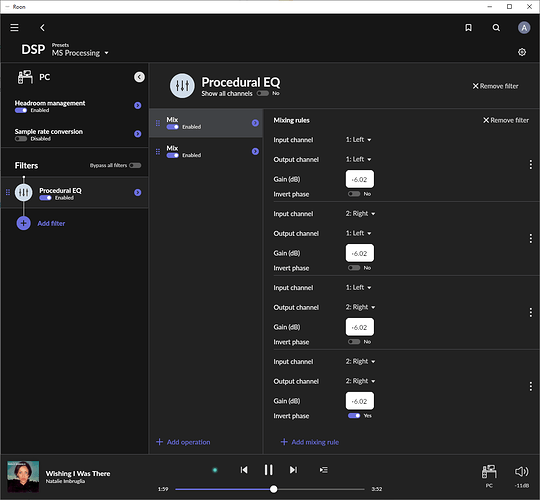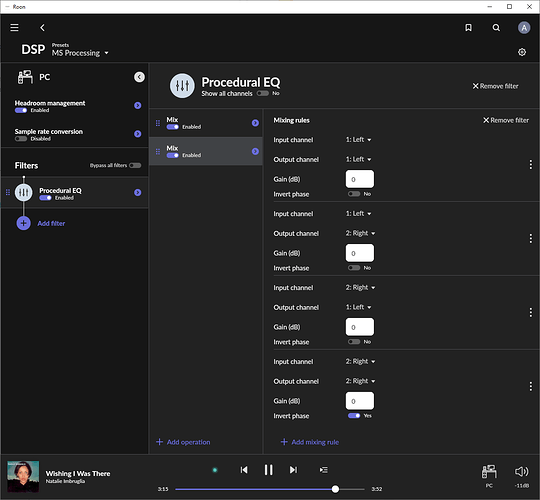Sometimes a room setup dictates that speakers have to be closer together than is ideal. In this situation, it would be nice to have a control that widens the stereo image so that sounds appear to arise at the sides beyond the speakers. I believe that this is a fairly simple matter of amplifying the difference (out of phase information) between the two channels - in effect, the reverse of the existing adjustment for headphone listening.
Maybe it is not the simplest way, but with Roon’s DSP feature you can build with Precedural EQ a filter that makes this effect. You select Add filter procedural EQ. Then +Add operation Mix. There you can setup mixing rules. You select as Input channel Left and as output channel Right. Then you toggle invert phase of this channel on and in Gain (dB) e.g. enter -12dB. This adds then to the right channel -12dB phase inverted left channel content, which as result puts part outside the right speaker, depending on the gain you can adjust how much. Then you do the same for the left channel.
Thank you. I hadn’t thought of that (I hadn’t previously used Procedural EQ).
I’ve tried your suggestion with a few gain settings. So far, in my set-up and depending on the recording, -1.5dB seems about right.
An interesting idea – using Procedural EQ within Roon to create attenuated stereo difference signals (L-R and its anti phase, R-L) in the standard L and R channels, respectively. It is a rudimentary form of surround processing/ambience extraction for two channel audio.
That does not look/sound right. Algebraically, a -1.5 dB attenuation would look like this…
L - 0.85R and R - 0.85L
Mixing -R and -L with only -1.5 dB attenuation into the L and R channels, respectively, will cancel almost completely any centered vocals and bass.
Can you post a screenshot of your Procedural EQ Mixing Rules? If you have it set up in what I believe is the most straightforward way, you will have four Mixing Rules:
L → L
R → R
-xR → L
-xL → R
…in which -x is the attenuation factor. I have found -10 dB to be a reasonable compromise.
AJ
Maybe this will help - it converts the L+R to M+S (mid + side) and allow for adjustment of the M vs S levels during a conversion back to L+R. This is basically what is done in production for stereo width control on specific parts in a track.
The following is a mix matrix to convert L+R to M+S (mid+side on left+right channels) with gain compensation (do not adjust anything here - the -6.02dB is specific to compensate for the summing). Usually each stage has a -3.01dB adjustment, but I’ve put twice the reduction in the encoding stage to and left it out of the decode stage to simplify use of the decoding stage mix adjustment.
This next mix matrix converts M+S (on left + right channels) back to L+R.
Remove the other unused channel entries in each mix (right click … and select remove).
If you adjust the gains of the first two mix rules in this second mix, then that will affect the contribution of the mid (mono) part of what you hear.
If you adjust the gain of the second pair of mix rules, then that will effect the side channel contribution and affect the apparent separation.
Maybe try -6 for the first pair and +6 for the second pair to get a sense of the effect. With the values in the second matrix all at 0, the output should be identical within 1/100th of a dB of the original due to the gain compensation in the first mix.
Personally I think many tracks sound quite broken (once you get over the novelty of it) when you fiddle with the intended mid/side levels beyond a small amount as basically you can end up massively enhancing chorus and flange effects and often the image is lost, or you get used to it and everything else sounds broken 
Thank you for the further responses.
I think I missed the fact in the original advice that I was supposed to mix a positive L to L and R to R with a negative L to R and R to L. I just did the negative bit. The result, certainly, was that the centre was very recessed, but, on some recordings at least, the effect was quite pleasant.
I’m going to try Adam’s suggestion, and will report back.
If all that you did was add two Mixing Rules that reversed L and R channels, inverted polarity, and reduced gain by -1.5 dB, then you did not change stereo width or center fill at all. But you thought that you had and reported some success. Placebo effect from level changes in audio can be quite powerful.
AJ
Sorry for having been misleading by short cutting my explanations on adding to l and r channels attenuated phase reversed r and l channels. But then Andrew put it in correct relation. In order not to bleed out the center (often bass and vocals) I suggested to reduce the amount of phase reverted r to l by -12dB. Obviously, to go the way Adam suggest is probably the best as it gives you the possibility to adjust mid and sides on left and right channels.
In general I want to indicate that the procedural EQ in Roon is quite a powerful tool to influence channel mix and equalizing, not only for stereo, but also in multichannel.
Would not +6 dB gain anywhere in the second Procedural EQ Mix run the risk of digital clipping (without Headroom Management elsewhere)? You have -6.02 dB (50 percent) attenuation in the first Procedural EQ MIx, but with constructive summation in the mix operation, that could bring levels back to 100 percent prior to the second Procedural EQ MIx.
AJ
Hmm. Thank you all again.
I’m not certain now what is real and what I’m imagining.
I’ve tried Adam’s suggestion. 6 in the second mix seems to push the centred vocals way back. Overall, the effect is interesting, but I’m not sure that it is an improvement. Still, it’s good to have it available.
True - I have headroom management on all the time anyway with a 6dB recuction, so yes, -12 and 0 would be safer depending on the material.
I suggested a huge separation to make the effect blatant. It is something you would need to tune - 0dB, -3dB for eg. However, I really think the only ‘fix’ is fiddling with speaker positioning and orientation.
Maybe a more useful discussion for you is about your room and speaker placement. I know you have got answers for the question you posted, but maybe it wasnt the right question to help fix your issue 
You can do some amazing processing in mixing with mid/side processing, but I very rarely use it on it own except to narrow a sound to help position and focus it. For widening it is always in conjunction with other processing (EQ and dynamics usually). For whole mix widening, then I have special processors for that that have a load of secret analog audio voodoo inside them 
With Roon, while I have not tried it, you could even do mid/side EQ (stick EQ between the pairs of mix rules), but while that might do something amazing for some tracks, for others it will probably badly compromise them as quite simply with some you would be enhancing the original mix intent and with others you would be fighting it.
I think that my brief experiments with using Procedural EQ Mixing Rules to enhance stereo difference content in the L and R channels are drawing to a close. Interesting but unsatisfying.
Increasing the stereo difference component enough to provide noticeably enhanced ambience/width concomitantly alters tonal balance – because of the decrease in centered bass.
Restoring tonal balance by decreasing the stereo difference enhancement renders the latter mostly moot.
Stereo difference extraction and insertion probably should be done on a band limited basis – perhaps L + R full range, L - R 200 Hz high pass. I seem to recall that Jim Fosgate’s Dolby Pro Logic II utilized subband steering along similar lines.
AJ
To understand what works and what doesnt and why, this can be interesting reading - Sound localization - Wikipedia. I have used information in this to drive experiments with precise sound positioning (with excellent results) in a DAW using combinations of band limited delays and side enhancement just to satisfy my curiosity (as it doesnt translate well to mono, so cant be exploited for production).
Tricky in my case: the main speakers are in the wall.
OK - I can see how that might be an issue 
Hammer?
You could have a look at the Black Ice FOZ SS-X as well
In fact, I already have a similar device (iFi micro itube2), but I have some trouble in accommodating another physical component, and, in any case, I don’t want something permanently in the replay chain. A switchable feature in roon would be perfect (well, I can dream).
Hi Andrew,
could it be that there is a mistake in your mid/side rules? Or am I mistaken?
Side signal must be. S = L - R (or R - L).
This is not in your rules, where you twice feed L and R back into themselves, and then revert these mixes.
Do I miss something?

